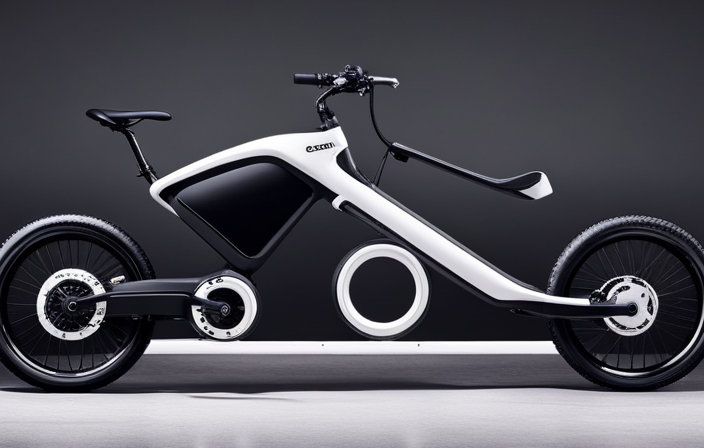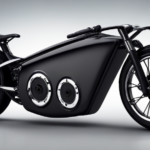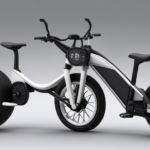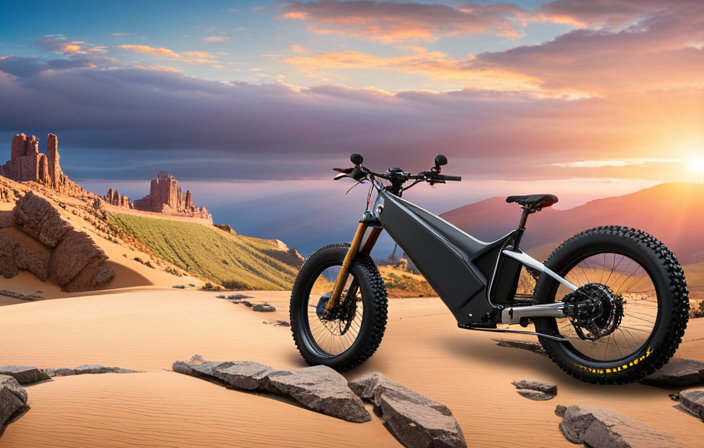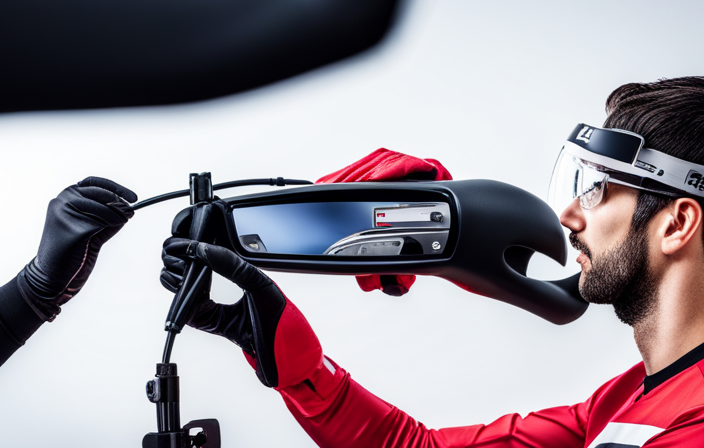Interested in purchasing an electric bike but unsure about which motor size to choose? It can be overwhelming with numerous options available, but don’t fret – we are here to help.
In this article, we’ll guide you through the process of understanding electric bike motors and help you determine the perfect size for your riding needs.
So, let’s dive in and find out what size motor is best suited for you.
Key Takeaways
- Accurate calculations are important for selecting the right motor size for an electric bike, considering factors like rider weight, terrain, and usage.
- Testing different motor sizes is crucial to determine the optimal performance, including speed, acceleration, and range.
- Budget considerations should be taken into account when choosing a motor size, balancing performance and affordability.
- There is a direct correlation between motor size and cost, with larger motors generally being more expensive but providing more power and speed.
Understanding Electric Bike Motors
Now, let’s talk about what size motor you’ll need for your electric bike. The size of the motor is crucial in determining the performance and capabilities of your electric bike. It is directly linked to the power output and speed that the bike can achieve.
When choosing the motor size, you need to consider several factors such as the terrain you’ll be riding on, your weight, and your desired speed. In general, a larger motor will provide more power and higher speeds, making it suitable for hilly terrains or if you want to ride at high speeds.
On the other hand, a smaller motor may be more suitable for flat terrains and for riders who prioritize energy efficiency and longer battery life. Determining your riding needs will help you select the appropriate motor size for your electric bike.
Determining Your Riding Needs
To figure out what kind of motor you need for your e-bike, start by determining how you plan to use it. Consider the following factors:
- Terrain: Will you be riding mostly on flat surfaces or tackling steep hills?
- Distance: How far do you plan to ride on a single charge?
- Speed: Do you want to reach high speeds or prefer a more leisurely pace?
- Load: Will you be carrying heavy cargo or just yourself?
By understanding your riding needs, you can choose the right motor size that meets your requirements.
Now, let’s explore the benefits of a small motor.
Benefits of a Small Motor
By choosing a smaller motor, you’ll experience increased maneuverability and greater efficiency.
A smaller motor allows for easier handling and navigation, especially in tight spaces or crowded areas. It gives you the ability to make sharp turns and navigate through traffic with ease.
Additionally, a smaller motor requires less power, resulting in greater efficiency and longer battery life. You’ll be able to cover longer distances on a single charge, making it ideal for commuters or those who enjoy longer rides.
Moreover, a smaller motor reduces the overall weight of the electric bike, making it easier to transport or store when not in use. This compact size also allows for a sleeker and more streamlined design, enhancing the aesthetics of your electric bike.
Now, let’s explore the benefits of a medium motor.
Benefits of a Medium Motor
If you opt for a medium-sized motor, you’ll enjoy a balance between maneuverability and power. The medium motor offers several advantages that make it a popular choice among electric bike enthusiasts.
- The medium-sized motor provides sufficient power to tackle hilly terrains without compromising on the bike’s agility.
- It offers a smooth and responsive ride, allowing you to accelerate quickly and maintain a steady pace.
- The medium motor is efficient, ensuring optimal battery usage and extending your riding range.
With a medium-sized motor, you’ll experience the best of both worlds – the ability to navigate through tight spaces and the power to conquer challenging routes.
However, if you’re seeking even more power, let’s explore the benefits of a large motor. A larger motor can provide enhanced performance and take your electric bike adventures to the next level.
Benefits of a Large Motor
With a larger motor, you’ll experience a significant boost in performance, taking your electric bike adventures to new heights. A large motor provides more power, allowing you to tackle challenging terrains and achieve higher speeds effortlessly. Let’s take a look at the benefits of upgrading to a larger motor:
| Benefits | Description |
|---|---|
| Increased Speed | A larger motor enables your electric bike to reach higher speeds, making your rides more thrilling and exciting. |
| Improved Torque | With increased torque, you can effortlessly climb steep hills and navigate rough terrain with ease. |
| Enhanced Range | The larger motor provides more power, extending your electric bike’s battery life and allowing for longer rides. |
| Better Acceleration | Experience quicker acceleration, allowing you to keep up with traffic and have a more dynamic riding experience. |
Considering Motor Placement
When deciding where to place the motor, you’ll want to consider factors such as weight distribution and accessibility. Proper motor placement is crucial for the overall performance and handling of your electric bike.
To achieve optimal weight distribution, the motor should be positioned towards the center of the bike frame. This ensures better stability, especially when navigating corners or uneven terrain.
Additionally, accessibility is important for maintenance and repairs. Placing the motor in a location that allows easy access will save you time and effort in case you need to address any issues.
Now that you have considered motor placement, let’s move on to another important aspect of building your electric bike: battery capacity and range.
Battery Capacity and Range
Now that you’ve decided on the placement of the motor, it’s important to consider the battery capacity and range for your electric bike.
The battery is the lifeblood of your electric bike, providing the power needed to propel you forward. The capacity of the battery is measured in ampere-hours (Ah), which determines how much energy it can store. A higher capacity battery will allow for a longer range, meaning you can travel further on a single charge.
It’s crucial to assess your specific needs and usage patterns to determine the appropriate battery capacity for your bike. Keep in mind that factors such as terrain, rider weight, and riding style can also affect the range of your electric bike.
Consultation and Test Rides
When it comes to choosing the right motor size for your electric bike, seeking expert advice can be crucial. Consulting with professionals who have extensive knowledge and experience in the field can help you make an informed decision based on your specific needs and preferences.
Additionally, trying out different motor sizes through test rides can give you a hands-on experience and a better understanding of how each size performs, allowing you to make a more accurate assessment of which one suits you best.
Seeking Expert Advice
If you’re looking for expert advice on the size of motor for an electric bike, you should consult with a professional in the field. They can provide you with valuable insights and recommendations based on their knowledge and experience. Here are three reasons why seeking expert advice is crucial:
-
Accurate calculations: A professional can accurately calculate the power and torque requirements of your electric bike, taking into account factors such as rider weight, terrain, and intended usage.
-
Optimal performance: By choosing the right motor size, you can ensure that your electric bike performs optimally in terms of speed, acceleration, and range.
-
Safety considerations: Experts can guide you in selecting a motor size that matches your skill level and ensures the safety of both you and other road users.
Trying Different Motor Sizes
After consulting with a professional, it’s important to test out various motor options to find the best fit for your needs. The size of the motor you choose will greatly impact the performance and efficiency of your electric bike. To help you make an informed decision, consider the following table that outlines the different motor sizes and their corresponding characteristics:
| Motor Size | Power Output | Acceleration | Top Speed |
|---|---|---|---|
| Small | Moderate | Average | Limited |
| Medium | High | Quick | Decent |
| Large | Very high | Rapid | Impressive |
Budget Considerations
When considering the cost differences between motor sizes for electric bikes, you need to carefully balance performance and affordability.
Choosing a larger motor may provide more power and speed, but it can also come with a higher price tag.
On the other hand, opting for a smaller motor may be more budget-friendly, but it could limit the bike’s overall performance capabilities.
It’s important to assess your specific needs and budget constraints to find the right balance between motor size, performance, and affordability.
Cost Differences Between Motor Sizes
You can save money by opting for a smaller motor size for your electric bike. When it comes to the cost of electric bike motors, there is a direct correlation between size and price. Smaller motors are generally more affordable compared to their larger counterparts. This is because smaller motors require less material and components, resulting in lower manufacturing costs.
Additionally, smaller motors often have lower power outputs, which can also contribute to their lower price tags. However, it is important to consider your specific needs and preferences when choosing a motor size. While a smaller motor may be more cost-effective, it may not provide the same level of performance and acceleration as a larger motor.
Therefore, it is crucial to find the right balance between performance and affordability to ensure that you get the most out of your electric bike without breaking the bank.
Balancing Performance and Affordability
Finding the right balance between performance and affordability is crucial when choosing the ideal motor for your electric bike. To help you make an informed decision, consider the following factors:
-
Power output: A higher power motor will provide greater acceleration and top speed, but it may come at a higher cost.
-
Battery efficiency: Look for a motor that maximizes the efficiency of your battery, allowing for longer rides without draining power too quickly.
-
Weight: Consider the weight of the motor as it will affect the overall weight and maneuverability of your bike.
-
Noise level: Some motors can be noisier than others, so if noise is a concern for you, opt for a quieter motor.
-
Maintenance: Research the maintenance requirements of different motors to ensure you choose one that is easy to maintain and doesn’t require frequent servicing.
Making an Informed Decision
When choosing the right motor for your electric bike, it’s crucial to consider various factors. One of the most important factors is motor size. However, it’s equally important to weigh motor size with other factors such as power output, battery capacity, and the type of terrain you will be riding on.
Weighing Motor Size with Other Factors
It’s important to consider other factors when weighing the size of the motor for an electric bike. While the motor size does play a significant role in determining the bike’s performance, there are additional aspects that need to be taken into account.
Firstly, you should consider the terrain you will be riding on. If you plan on tackling steep hills or rough terrains, a more powerful motor would be necessary.
Additionally, the weight of the rider and any cargo should be considered. Heavier riders or those carrying extra load may require a larger motor to ensure optimal performance.
Lastly, the desired range or distance you want to travel on a single charge should be factored in.
Once these considerations are made, you can proceed to choose the right motor for your electric bike, taking into account all the relevant factors.
Choosing the Right Motor for Your Electric Bike
Considering the terrain, weight, and desired range are all important factors to consider when choosing the right motor for your e-bike.
The terrain you plan to ride on plays a crucial role in determining the motor size. If you’re mainly riding on flat surfaces, a smaller motor may be sufficient. However, if you’ll be tackling steep hills or off-road trails, a more powerful motor will be necessary.
Weight is another key consideration. If you’re a heavier rider or plan to carry heavy loads, a larger motor will provide the necessary torque to handle the extra weight.
Lastly, the desired range of your e-bike will also influence the motor choice. If you need to cover long distances, a motor with higher wattage and a larger battery capacity will be ideal.
Ultimately, selecting the right motor involves carefully analyzing these factors to ensure optimal performance and efficiency for your specific needs.
Conclusion
In conclusion, when choosing the size of the motor for your electric bike, it is crucial to consider your specific riding needs.
A small motor, like a hummingbird’s wings, offers agility and efficiency for urban commutes.
A medium motor, akin to a cheetah’s stride, provides a balance between power and maneuverability for diverse terrains.
Lastly, a large motor, resembling an eagle’s soar, delivers superior strength and speed for off-road adventures.
By carefully evaluating battery capacity, range, and budget, you can make an informed decision that ensures a thrilling and reliable electric biking experience.
